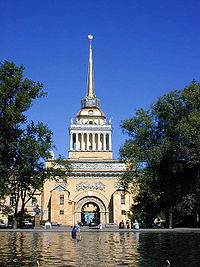- Russian frigate Oryol
-

Career (Russia) 
Launched: 1668 Commissioned: 1667 In service: 1669 Out of service: 1670 Fate: Captured and burnt, 1670 General characteristics Tons burthen: 250 tonnes (250 long tons) Length: 24.5 m (80 ft 5 in) Beam: 6.5 m (21 ft 4 in) Propulsion: Sails Sail plan: Full rigged ship Complement: 23 sailors, 35 soldiers Armament: 22 guns The frigate Oryol (Russian: Орёл, "eagle"; also Orel) was the first Russian-built warship, commissioned by Tsar Alexis I to protect Russian trading ships on the Caspian Sea. The Oryol was built between 1667 and 1669 by the developing shipyard in Dedinovo, on the Oka River.[1] Although the Oryol was captured and burned in 1670, it has achieved lasting importance as a symbol of the birth of Russian naval power.
The Oryol is often considered the first Russian sailing ship of Western European type, even though the Frederick (or Friedrich) was built in 1636 in Nizhny Novgorod. However, the Frederick sailed in the service of Holstein-Gottorp, not Russia, having been constructed as a joint venture using Russian labor and materials, but Holstein funds and expertise.[2]
Contents
Construction
During the 17th Century, Russia and Persia developed closer commercial ties, exchanging extravagant embassies and trading in cloth, silk, and other goods. Shipping was conducted across the Caspian Sea and through the Volga River, with Astrakhan as commercial center. This route served to open Persia to commerce not only with Russia but with all of Europe; Dutch and English traders were active, and Adam Olearius was sent as an emissary from Schleswig-Holstein.[3]
In order to protect this growing trade, Tsar Alexis I ordered a naval shipbuilding program. The shipyard was constructed south-west of Moscow in Dedinovo, a town on the Oka River in present-day Moscow Oblast. The project was placed under the Novgorod Chancery, supervised by the boyar Afanasy Ordin-Nashchokin. Experienced sailors were hired from Amsterdam, and the Karnelius van Bockhoiven, a Dutchman living in Moscow, was hired for his shipbuilding expertise. The Oryol was the first large ship produced, along with a yacht and two smaller vessels. It was a three-masted sailing ship, 24.5 meters in length, 6.5 m wide, and displacing 250 metric tons. It had a crew of 23 sailors and 35 soldiers, and was armed with 22 guns.
Although the Oryol was launched in 1668, it was not yet finished and spent the winter at dock in Dedinovo. It finally left the shipyard on May 7, 1669, under the command of the Irishman David Butler, who had been brought from the Netherlands. The warship sailed down the Volga to its base in Astrakhan, from which it would protect shipping on the Caspian Sea.[2]
Destruction
The Oryol arrived in Astrakhan in August of 1669, but never fulfilled its mission and may never have sailed on the Caspian Sea. The rebel forces of Stenka Razin were raiding Russian towns, and the ship's guns and men were ordered to defend Astrakhan while the ship sat at anchor. Some of the ship's guns were removed to the citadel, and when the Cossacks attacked the city in June of 1670, the Oryol was at anchor and undefended.[4] The rebels took the ship and either burned it[2] or disabled and abandoned it in a channel of the river.[1]
Captain Butler's own account of the occupation of Astrakhan and the destruction of the Oryol was published in 1683 along with the voyages of the Dutch traveler Jan Struys.[5]
Symbolic significance
The image of a sailing ship at the top of the Admiralty spire in Saint Petersburg bears a strong resemblance to, and may have been modeled after, the Oryol. The original golden weather-vane, work of the Dutch master Harmen van Bol'es, remained in place until 1886, when it was moved to the Admiralty's naval museum and replaced with an exact copy. The three-masted ship has become an emblem of the city of Saint Petersburg.[6]
The earliest record of the Russian white, blue, and red tricolor comes from the flag flown on the Oryol. This flag was later made standard for all Russian ships by Peter the Great.[7] There are several traditional explanations for the choice of colors. According to one version, the design was based on the Dutch flag in honor of the ship's builders and crew. Alternatively, the three colors may have been taken from the insignia of the Grand Duchy of Moscow.[8]
References
- ^ a b c Phillips, Edward J. (1995). The Founding of Russia's Navy. Greenwood Publishing Group. ISBN 0313295204. http://books.google.com/books?id=AwK3pQaf5EYC. Retrieved 2008-08-12.
- ^ Jackson, Peter; Laurence Lockhart (1986). The Cambridge History of Iran: The Timurid and Safavid Periods. Cambridge University Press. p. 472–474. ISBN 0521200946. http://books.google.com/books?id=EF_4AQeOltUC. Retrieved 2008-08-13.
- ^ Avrich, Paul (1976). Russian rebels, 1600-1800. W. W. Norton & Company. ISBN 0393008363. http://books.google.com/books?id=IktG6YL2JawC. Retrieved 2008-08-12.
- ^ Struys, Jan (1683). The Perillous and most Unhappy VOYAGES of JOHN STRUYS, Through Italy, Greece, Lifeland, Moscovia, Tartary, Media, Persia, East-India, Japan, and other Places in EUROPE, AFRICA and ASIA. [...] To which are added 2 Narrativs sent from Capt. D. Butler, relating to the Taking in of Astrachan by the Cosacs.. Samuel Smith.
- ^ Savinova, Yulia (May 30, 2002). "Один из символов столицы" (in Russian). Панорама ЛОМО. http://www.lomo.ru/site/news/index.php?cn=451&ct=6&pg=1. Retrieved 2008-08-12.
- ^ "Russia's State Symbols: National Flag". RIA Novosti. June 7, 2007. http://en.rian.ru/symbols/20070607/66606494.html. Retrieved 2008-08-12.
- ^ Klimov, Dmitry (September 13, 2002). "Great and Powerful". Moscow News. http://www.mnweekly.ru/news/20070913/55275732-print.html. Retrieved 2008-08-13.
Categories:- Frigates of Russia
- Muscovite Russia
- 17th century in Russia
- 1660s ships
Wikimedia Foundation. 2010.



